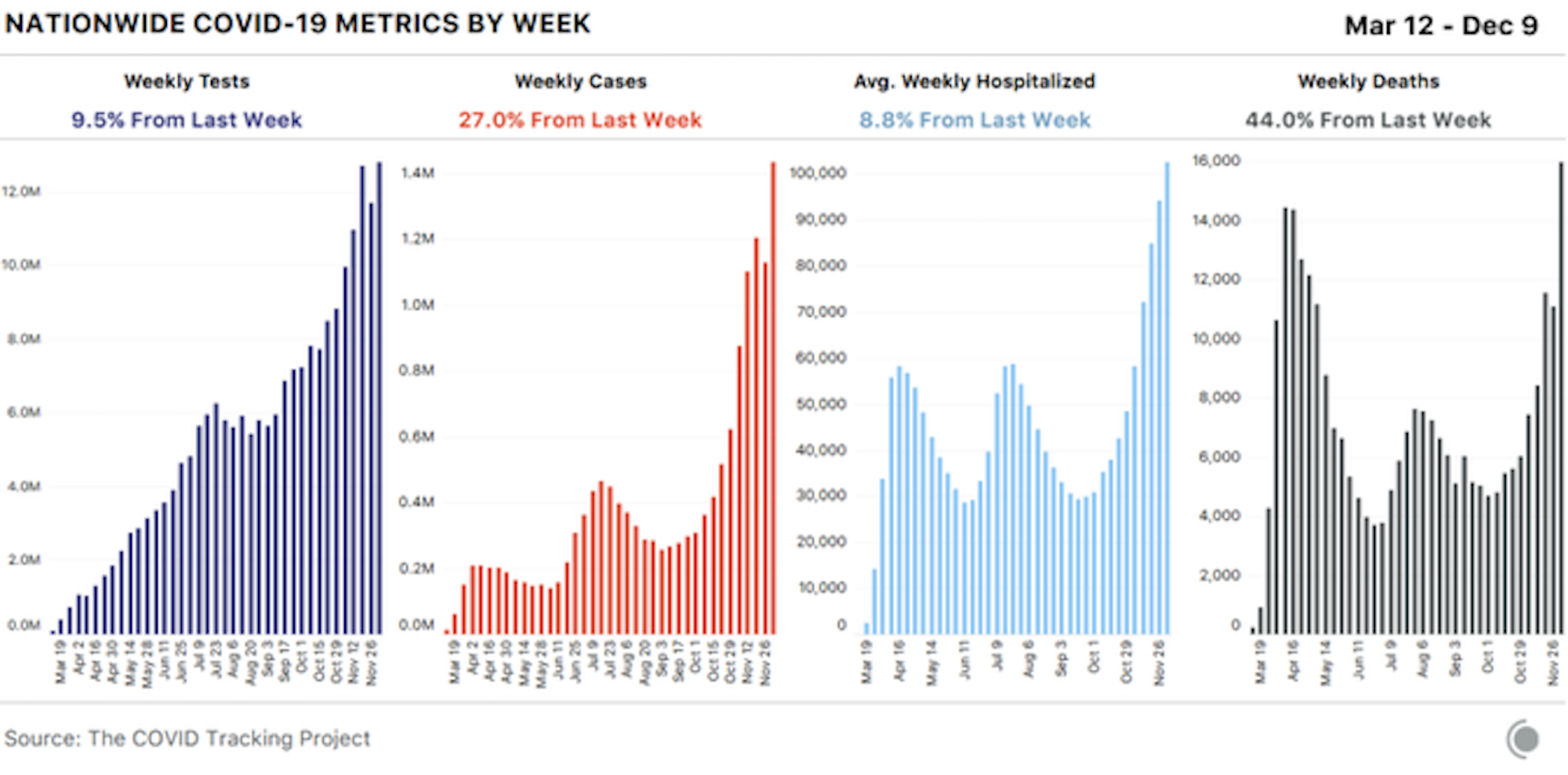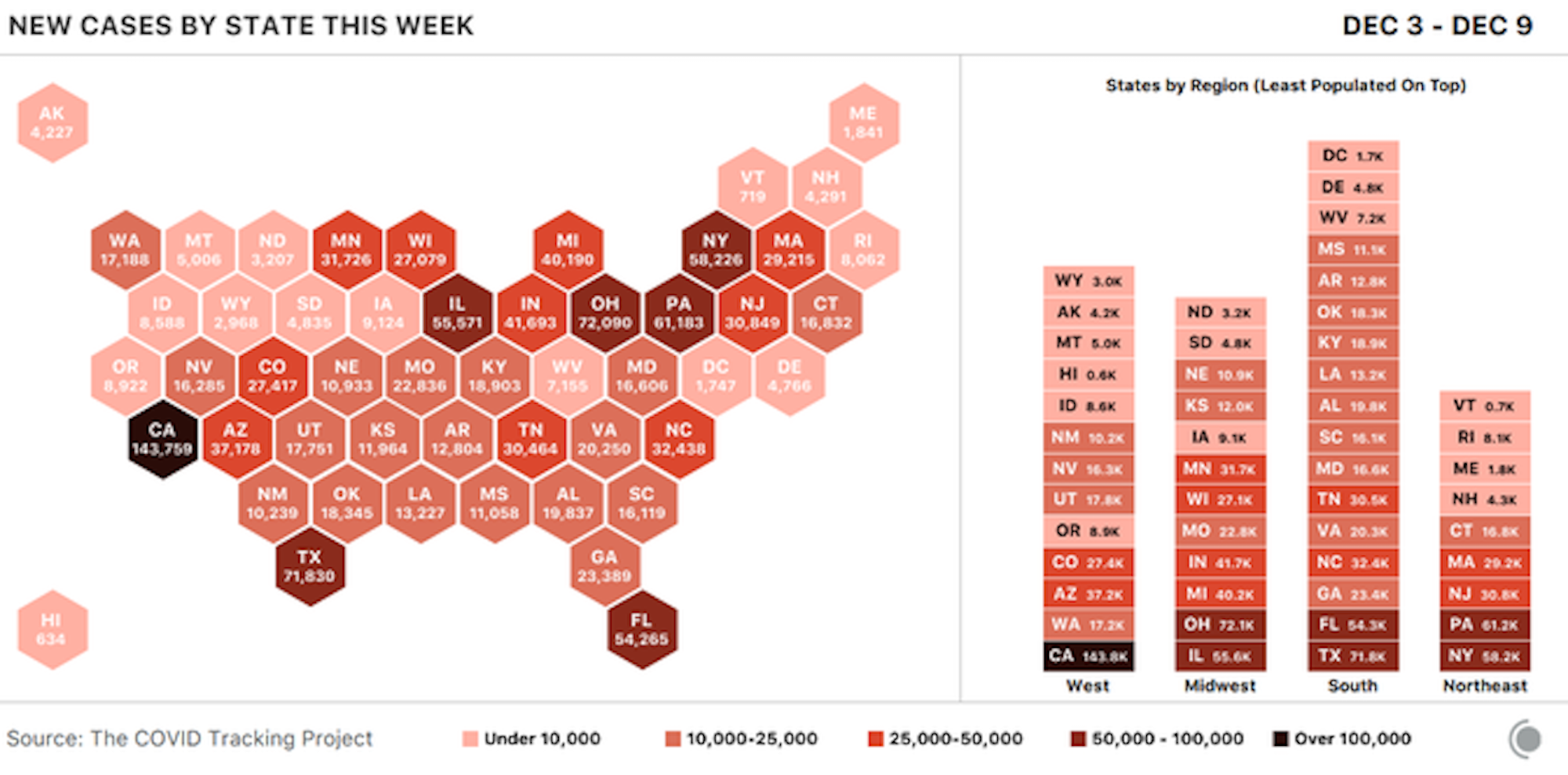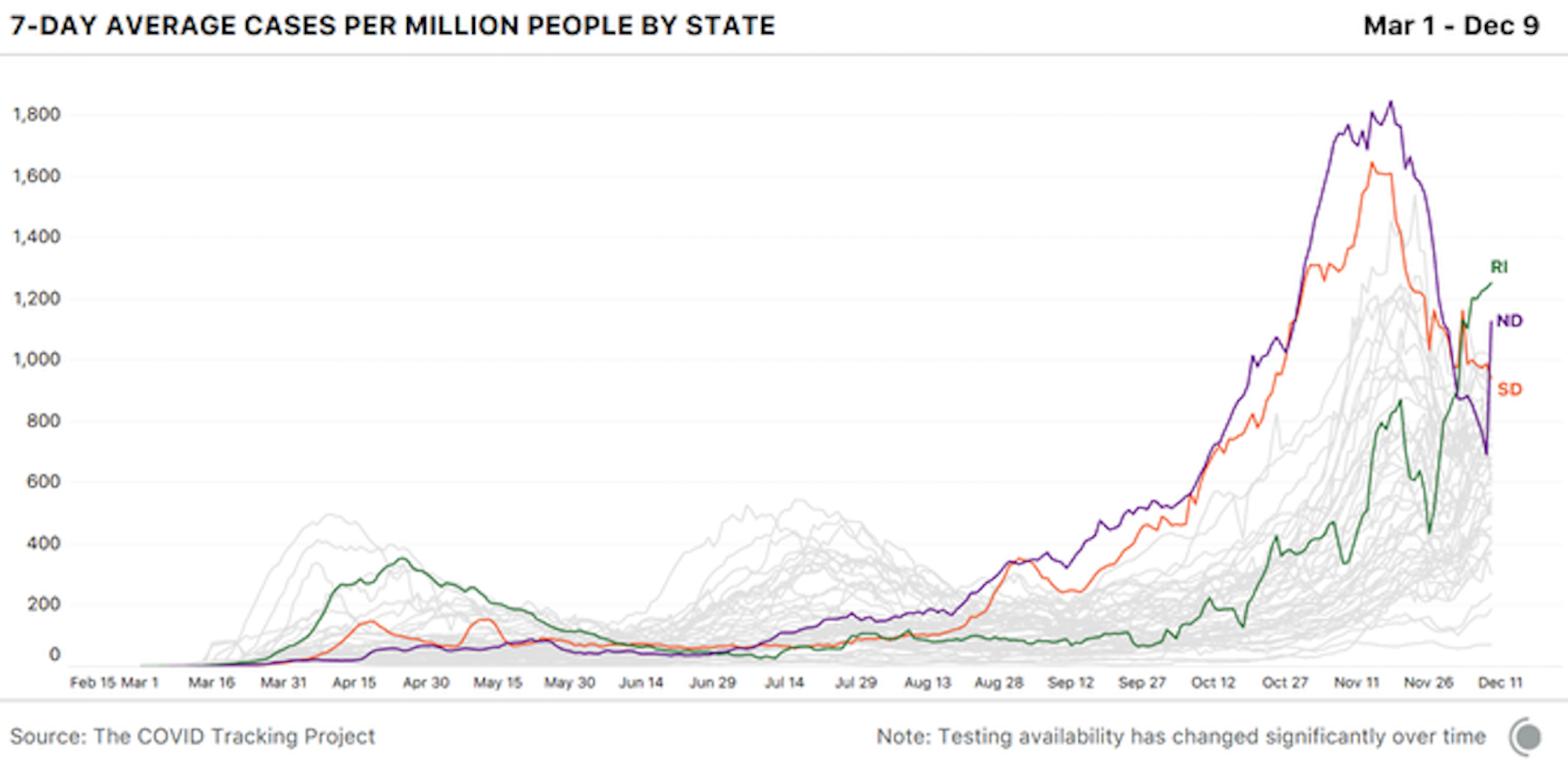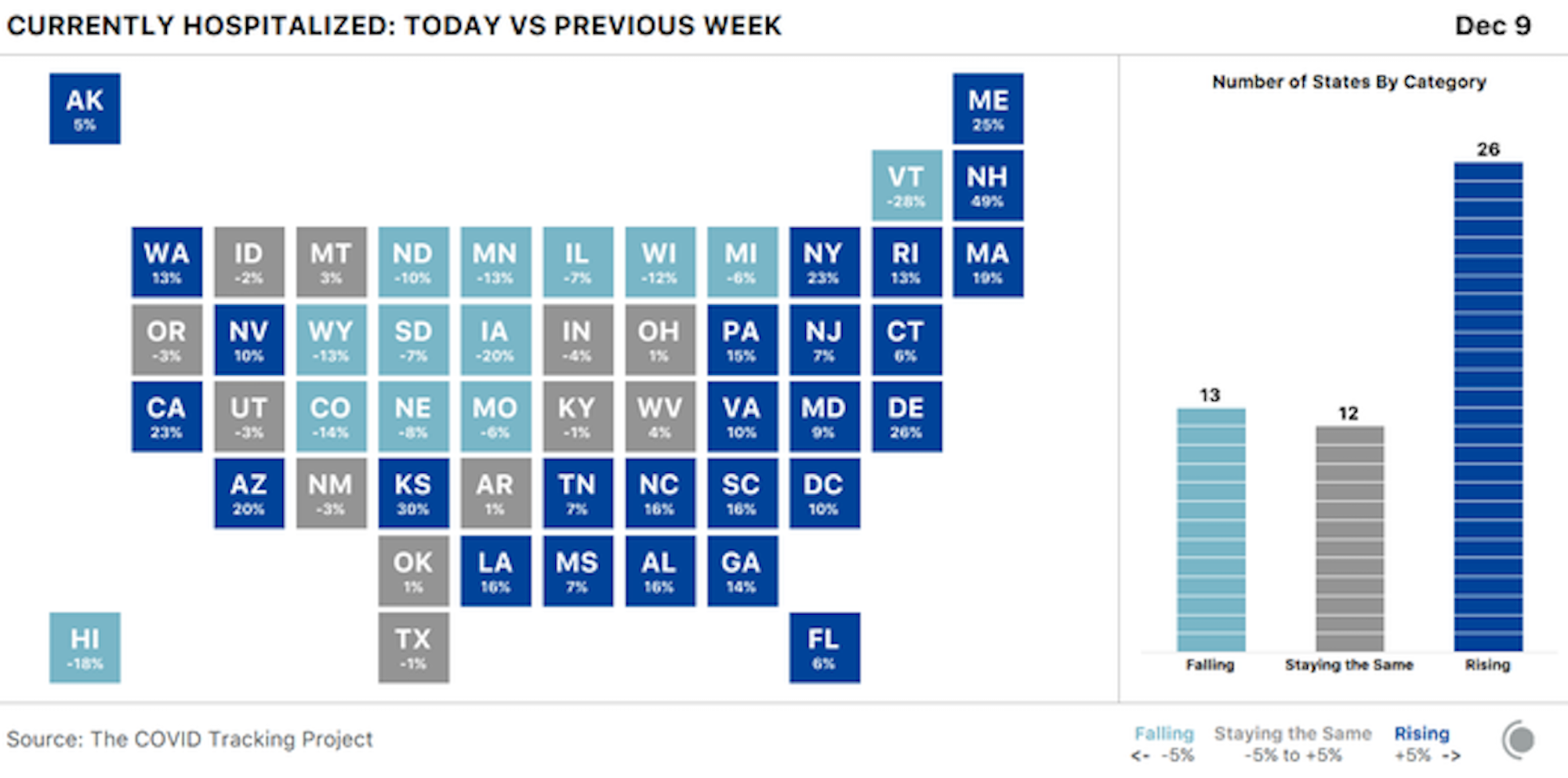
By nearly all measures, it has been a horrible week, a horrible month (10 days in), and a horrible year. The United States this week set records in all three metrics that gauge the pandemic’s severity, with a total of 1.4 million new cases and 15,966 deaths. Yesterday, states and territories reported 3,088 deaths from COVID-19—a record no one wanted to see—and the average number of deaths per day over the past 7 days exceeded 2,000, surpassing the highest average we saw in the spring’s deadly first surge. More than 106,000 people are currently hospitalized with COVID-19.

If the patterns we’ve traced since the spring hold true, the worst is yet to come. Given the rapid increase in the number of new cases, we expect the metrics for hospitalizations and deaths to continue rising in the coming weeks—especially if in-person gatherings over Thanksgiving weekend led to increased spread of the coronavirus, as public-health experts warned would happen.
A crucial bit of muddiness remains in the data themselves: Some of the reported deaths we are seeing now are likely related to the post-Thanksgiving backlog we’ve written so much about in the past couple of weeks. What’s not exactly clear is how many of these deaths are following the case increases that occurred before and during the holiday week. Either way, we expect that deaths will climb steeply given current case and hospitalization numbers. Test reporting, too, is probably still slightly low because of the holiday effect. Case numbers appear to be largely back online following the holiday reporting disruption, however, which makes sense—historically, case numbers have been quicker to recover from holidays and weekends than tests and deaths.
Case numbers were high across the U.S. this week, with each of the country’s seven most populous states reporting more than 50,000 new cases among their residents. Fourteen states in regions across the U.S. reported a record number of cases this week; that’s on top of the 16 states that hit new-case records last week.

The slowing case growth in midwestern states that we noted last week have continued: After the Thanksgiving data dip and subsequent rise, new cases appear to be declining in the region. Meanwhile, in the Northeast, South, and West, cases are rising sharply.
After 14 weeks of North or South Dakota posting the highest per capita case numbers in the country, Rhode Island has taken their place, with 1,253 cases per million on the seven-day average. (The below chart, along with most of the others we use in our weekly posts, is available as a mobile-friendly interactive tool in the Charts section of our site.)

With the catastrophic rise in cases, communities of color across the country have been especially hard hit by the terrible effects of the pandemic. In Rhode Island, more than one in eight Latino people has tested positive for COVID-19, compared with one in 31 white people. In both North and South Dakota, one in eight Black people has tested positive. Some of the highest per capita statistics are being reported for American Indians and Alaska Natives. South Dakota is reporting that one in seven Native Americans has tested positive for COVID-19. Notably, as case disparities between some other racial and ethnic groups have decreased in South Dakota, that has not been the case for Native Americans, for whom the weekly new cases reported per capita have been higher than for any other group, or the state overall, for the past three months. In surveying racial and ethnic disparities in other parts of the country, we also note that in Louisiana, one in six Asian people has tested positive for COVID-19.
Hospitalizations rose in 26 states this week, mostly concentrated in the Northeast, South, and parts of the West. We believe these rising numbers indicate that outbreaks will continue to worsen in many of the country’s most populous states. Although the Midwest still has the highest per capita number of people hospitalized, the actual numbers there are falling; nine states in the region reported drops in the number of people hospitalized compared with last week.

New Hampshire, Delaware, and Maine reported the largest percentage increases in COVID-19 hospitalizations in the past week, with California and New York right behind them. In California, the already high number of hospitalized COVID-19 patients rose 23 percent from last week; the state is reporting that, statewide, ICUs are 90 percent full. ICUs in Silicon Valley and parts of the Central Valley are full, and San Francisco, which long maintained relatively low case levels given the city’s density and population, now says it may run out of hospital beds in the coming weeks. In Los Angeles County, ICU and overall hospital capacity are running low, and a record 1,719 health-care workers in the county reported last week that they have COVID-19, more than double the number who reported they were sick the week before.
The pandemic continues to play out in particularly distressing ways in long-term-care facilities. As our LTC team reported yesterday, a surge in cases in the Northeast and West continues; last week, both regions reported their highest numbers of new cases in the past six months. The Midwest and South saw a small downturn in new cases, which is promising, yet the week still saw the nation’s highest number of newly reported cases—51,574—in long-term-care facilities since the COVID Tracking Project began collecting these data in May. And, as we always note, these figures are an undercount, since not every state reports long-term-care data.
Nearly 40 percent of the new cases in the Northeast came from Pennsylvania; the state reported more new cases of COVID-19 in LTC facilities than any other state except California, which has more than three times as many residents. Our researchers have been unable to obtain current data about the number of people living in Pennsylvania’s long-term-care facilities. But if numbers have remained relatively constant over the past five years, we can estimate, based on a 2015 number of residents in LTC facilities and available COVID-19 data from the state, that nearly 30 percent of people living in Pennsylvania LTC facilities have had COVID-19. And nearly one in five Pennsylvania long-term-care residents who has contracted the virus has died.
No comments:
Post a Comment